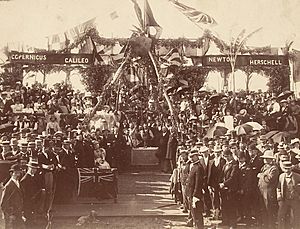William John Hancock facts for kids
William John Hancock (born May 2, 1864 – died August 26, 1931) was an amazing Australian engineer. He was born in Ireland but became a very important person in Western Australia. He was a pioneer in two big areas: setting up telephone systems and using X-rays for medicine. He even helped hospitals in Perth and Fremantle with X-ray services for free!
When X-rays were first discovered, many doctors in Australia were slow to use them. It was often people like scientists or electricians, who already worked with electricity, who first experimented with X-rays. They were excited by this new technology. Over time, as hospitals started getting their own X-ray machines, doctors began to accept this new way of looking inside the body.
Contents
Early Life and Education
William John Hancock was born in Dublin, Ireland, in 1864. His father, also named William John Hancock, worked as an actuary (someone who deals with statistics and risks).
Young William went to the University of Glasgow in Scotland. He studied engineering for two years. He was lucky enough to learn from famous teachers like James Thomson and William Thomson, who later became known as Lord Kelvin.
In 1910, Hancock married Ida Helen Lovegrove in Perth, Western Australia. They did not have any children. He passed away in London in 1931.
Building Connections: Telephone and Telegraph Pioneer
After finishing his studies, Hancock started working at the Dublin Telephone Exchange. This job gave him great experience with telephone systems. At that time, the Dublin Exchange had 900 customers who made about 7,000 phone calls every day!
Bringing Telephones to Western Australia
In 1886, Hancock moved to Perth, Western Australia. He became the superintendent of telephones for the government. His main job was to set up telephone exchanges in Perth and Fremantle. He oversaw the building of telephone lines, including one connecting Government House to the Colony Secretary's office. The first telephone system he installed had 17 customers.
Connecting the State with Telegraph Lines
Hancock also built many telegraph lines across Western Australia. He connected Perth to places like Roebourne, Broome, Derby, Hall's Creek, and Wyndham. He also installed lines to Kalgoorlie and Marble Bar. Building these lines was tough! They faced challenges from native Aboriginal people, insects like ants and termites, extreme heat, and bushfires. They even had to use iron wire instead of copper wire because the copper would melt in the heat.
Overseeing Electrical Works
In 1894, Hancock was made the government electrical engineer. He held this important job until he retired in 1922 due to poor health. In this role, he supervised all electrical projects in Western Australia. This included the tramway systems and the installation of underwater cables in the harbors of Fremantle and Bunbury.
X-ray Pioneer in Western Australia
In January 1896, news of Wilhelm Röntgen’s amazing discovery of X-rays reached Western Australia. Just a few months later, in August 1896, William Hancock showed off his own X-ray machine in Perth. He had brought it all the way from London!
In 1898, he was given an honorary (unpaid) position as a radiographer at the Perth Public Hospital. He kept this role for more than 20 years. During the day, he worked as an engineer, but in the afternoons and evenings, he volunteered his time, X-ray services, and even his own equipment to help the public. It's thought that he performed between 20,000 and 30,000 X-ray exposures during his time there!
Awards and Recognition
William John Hancock's contributions were recognized in many ways.
When the Perth Observatory foundation stone was laid in 1896, important items were placed in a time capsule underneath it. Among these items were "Röntgen rays tubes, and a description of the process, together with specimen photographs" that Hancock had donated. This was the first known time capsule in Western Australia!
In 1936, a special face mask (a bust) was put up in Canberra to honor Dr. William John Hancock. It celebrated his service to Australia as a pioneer of X-rays and radiology in Western Australia.
- In 1924, he received the Kelvin Gold Medal from the Royal Society of Western Australia. He was the very first person to get this award.
- Also in 1924, the University of Western Australia gave him an honorary doctorate of science.
- He was also a member of the University of Western Australia's Senate from 1915 to 1927.
Memorial Window at the University
In 1934, a beautiful stained glass window was placed in Winthrop Hall at the University of Western Australia. This window was created to remember William John Hancock, the X-ray pioneer and former member of the University Senate.
The window's inscription reads: "In honour of William John Hancock, Doctor of Science, pioneer in radiology in Western Australia, 1864-1931." The design includes symbols of science, learning, and healing. It also features Dr. Hancock's family crest at the bottom, which has a cock (a type of bird) and an Irish shamrock, along with the motto "Vincit Amor Patriae" (which means "Love of Country Prevails").
Professional Service
William John Hancock was involved in many important organizations:
- He was the secretary for the Perth Public Hospital from 1897 to 1913.
- He served as secretary for the Western Australian branch of the British Medical Association from 1918 to 1931.
- He was the registrar for the Medical Board of Australia from 1927 to 1931.
- He was a member of the British Medical Association and the Weld Club.
- He was also a member of the Institution of Electrical Engineers (M.I.E.E.) and the Institution of Civil Engineers (M.I.C.E.).
- He held qualifications from the Royal College of Surgeons (M.R.C.S.) and the Royal College of Physicians (L.R.C.P.).


